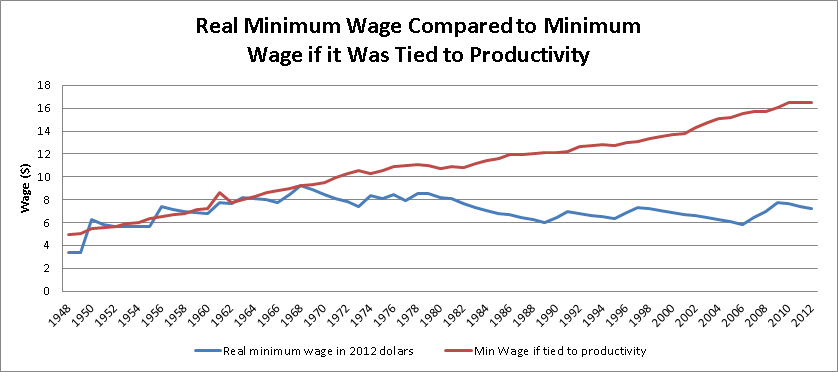The Australian minimum wage this year is $15.96 per hour. I know this mostly because my daughter lives in Melbourne these days (not forever, I hope). When she arrived there 18 months ago, she got a job at a minimum-wage restaurant. She earned enough to cover her rent and other expenses.
The Australian minimum wage this year is $15.96 per hour. I know this mostly because my daughter lives in Melbourne these days (not forever, I hope). When she arrived there 18 months ago, she got a job at a minimum-wage restaurant. She earned enough to cover her rent and other expenses.
What brought the idea of a much higher minimum wage to mind is a blog post today from Dean Baker of the Center for Economic Policy Research. Dean estimates that the U.S. minimum wage today would be $16.54 per hour if it had kept pace with U.S. productivity growth since 1947.
For those with knowledge of economic history (both of us), a minimum wage that increases its buying power every year does not seem far fetched, even in the good old United States. The U.S. minimum wage DID increase with productivity growth from 1948 to 1968. This linkage (see Dean’s chart below) resulted from the combined impact of two mechanisms: manufacturing wages kept pace with productivity growth thanks to collective bargaining in mass manufacturing (starting with the famous auto industry “Treaty of Detroit” in 1948); and Congress periodically increased the minimum wage to bring it back up to 50% of the average manufacturing wage.

Click on the chart above for a larger view
In recent decades, the most ambitious aspiration in U.S. political debate has been that the minimum wage keep pace with inflation (even Mitt Romney was for this briefly — after he was against it and before he wasn’t sure any more).
If you think about it for a second, a minimum wage that keeps pace with inflation is a fairly pathetic aspiration. It means that our lowest-wage workers get to have their living standards stay the same forever, even as the economic pie keeps growing with increases in productivity.
Wages — and minimum wages — that keep pace with productivity growth express a different and completely practical aspiration: the idea that workers at all levels should share in the expanding economic pie. Fair reward for hard work. Even sounds like a fundamental American value. Let’s get back to it. If we did, Charlotte might even come home.